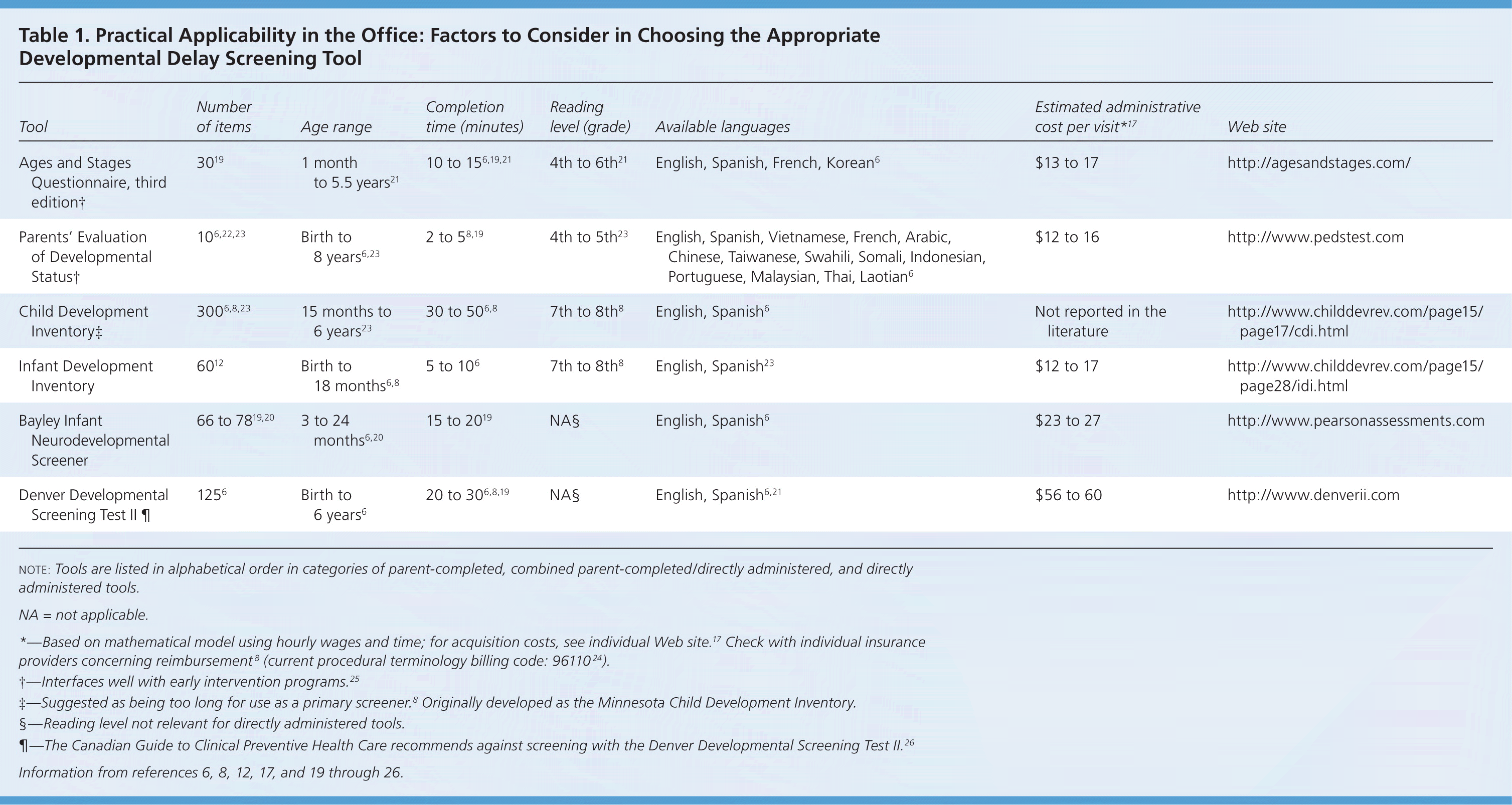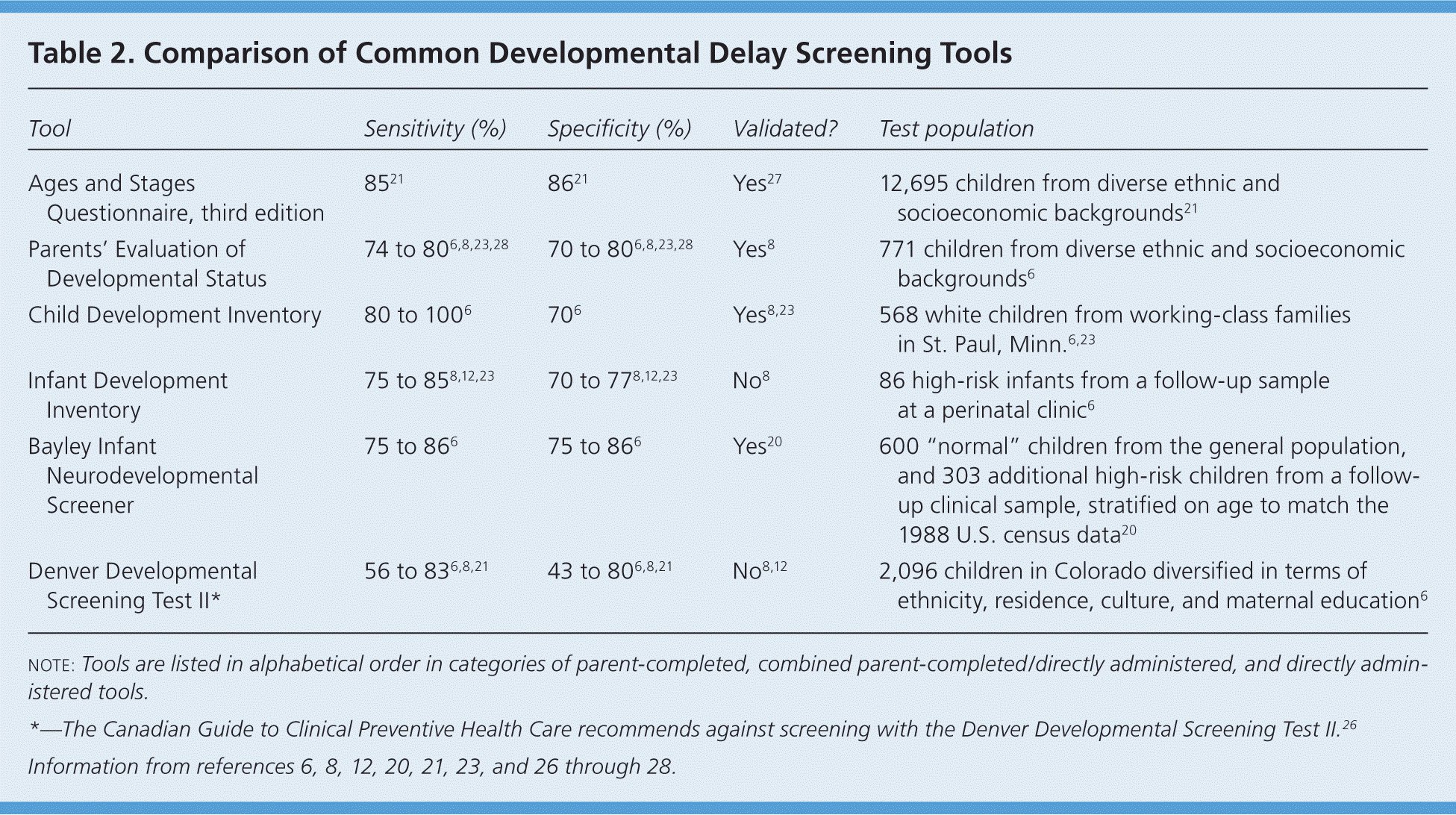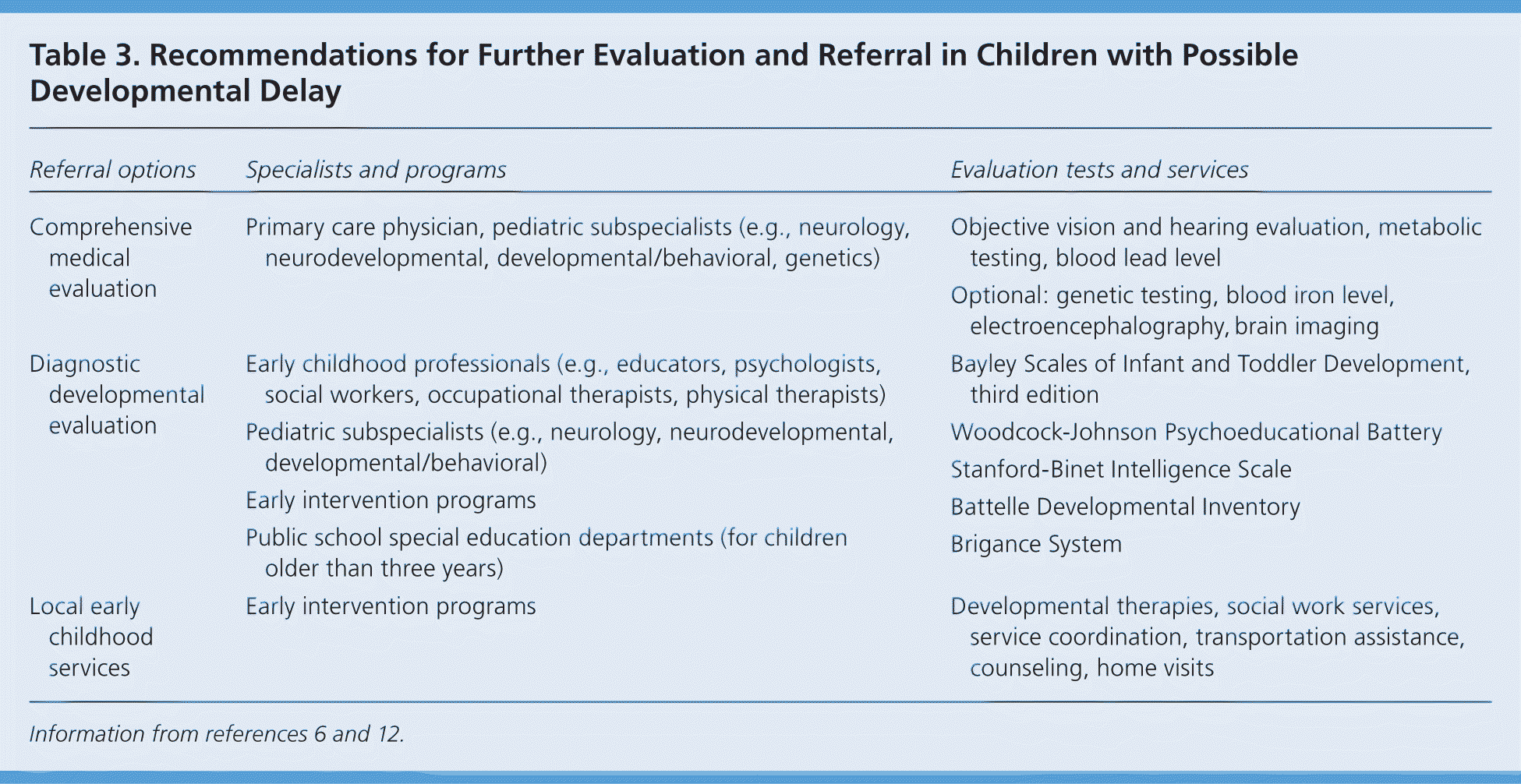
A more recent article on develpmental screening and surveillance in young children is available.
Am Fam Physician. 2011;84(5):544-549
Author disclosure: No relevant financial affiliations to disclose.
According to the literature, 12 to 16 percent of children in the United States have at least one developmental delay, yet as many as one-half of affected children will not be identified by the time they enter kindergarten. If developmental delays are detected too late, opportunities for early intervention may be lost. Empirical literature on clinical recommendations for developmental delay screening in primary care is inconsistent and often insufficient to direct the family physician. In addition, multiple barriers exist, which often prevent physicians from performing initial screening and completing additional evaluation and referrals. Implementing office-based systems for screening and referrals may overcome these barriers and improve outcomes. Recent studies support the use of a validated screening tool at regular, repeated intervals, in addition to physician surveillance, at all well-child visits. The literature also supports screening for developmental delay with parent-completed tools rather than directly administered tools. The most extensively evaluated parent-completed tools are the Parents' Evaluation of Developmental Status and the Ages and Stages Questionnaire. Family physicians should be familiar with currently available screening tools, as well as their limitations and strengths. Additional evaluations and referrals are recommended if developmental delay is identified or suspected.
Providing high-quality care for young patients can be challenging, especially identification of possible developmental delay. Twelve to 16 percent of children in the United States have at least one developmental delay,1,2 but early detection is complicated by conflicting national screening recommendations.
The U.S. Preventive Services Task Force (USPSTF) reports that there is insufficient or inconsistent evidence to recommend for or against routine use of brief, formal screening instruments in primary care to detect speech and language delay in children up to five years of age.3,4 The recommendation is not a statement for or against the effectiveness of formal screening, but a conclusion of the current state of strong evidence to support specific clinical preventive services. The American Academy of Family Physicians agrees with the USPSTF's rigorous assessment of empirical evidence.5 The American Academy of Pediatrics recommends surveillance at all well-child visits, combined with standardized screening for developmental delay at nine, 18, and 30 (or 24) months of age, as well as at every well-child visit when developmental delay is suspected.6 This policy is intended to disseminate clinical preventive service recommendations based on empirical and clinical evidence revealing either clear benefits or harm.7
Because subtle disabilities such as language impairment, mild intellectual disabilities, and learning disabilities are associated with poorer health status and higher rates of school failure, in-grade retention, and special education, early intervention is generally thought to improve outcomes.8–10 Based on evidence from controlled studies, early intervention for premature infants, low-birth-weight infants, and children from families with low socioeconomic status has been shown to improve IQ and result in higher academic achievement, increased adult employment, and decreased criminality.8,11 If developmental delays are detected too late, however, opportunities for early intervention may be lost.12,13 The USPSTF states that it is ultimately the responsibility of the physician to seek out and address parental concerns about speech delays.3
The Individuals with Disabilities Education Act Amendments of 1997 and Title V of the Social Security Act mandate that health care professionals provide early identification and intervention for developmental delays within community-based collaborative systems.6,13,14 In 2005, the Centers for Disease Control and Prevention recommended the use of a brief developmental assessment to identify children who should receive more intensive diagnosis or evaluation.13 More quality research is needed to establish consistent clinical recommendations for primary care.
| Clinical recommendation | Evidence rating | References |
|---|---|---|
| The American Academy of Pediatrics recommends surveillance at all well-child visits, combined with screening for developmental delay at nine, 18, and 30 (or 24) months of age using a standardized developmental screening tool. | C | 6 |
| Validated screening tools should be used instead of surveillance alone in assessing developmental delay. | C | 6, 8, 12 |
| When screening for developmental delay, a parent-completed tool (e.g., Parents' Evaluation of Developmental Status; Ages and Stages Questionnaire, third edition) should be used over a directly administered tool. | C | 8, 12, 16, 19, 29 |
Surveillance vs. Screening
As many as one-half of American children with developmental delay will not be identified by the time they enter kindergarten, even though most will show mild developmental delays by two years of age.12,15 One reason for low detection rates is high dependence on clinical surveillance alone. Surveillance methods such as checklists and clinical observation have poor sensitivity.12 Reports show that clinical judgment alone is inadequate and insensitive.8 One study revealed that physician impression alone would have missed 45 percent of children eligible for early intervention.16 Because children's development is dynamic in nature, regular and repeated screening combined with surveillance is needed to detect developmental delays.6,12
Barriers to Screening
Developmental delay can be identified with reasonable accuracy using a screening tool,8 yet only 23 percent of primary care clinicians report using standardized screening tools.1 Multiple barriers to screening exist, including time constraints, competing clinical demands, cost burden, staffing requirements, lack of consensus on the most suitable tools for the general childhood population, and lack of physician confidence because of insufficient training and expertise.1,2,9,17 Additional barriers noted in a recent study were high staff turnover, unequal distribution of screening tools, and lack of reimbursement for the 30-month visit.18 In one study, 82 percent of primary care clinicians cited ongoing time constraints as the most prominent barrier.19
Tools for Developmental Screening
The literature does not identify a criterion standard in developmental assessment, other than the lengthier screening test performed after a referral has been made.12 Criterion standard is defined as an ideal test that covers all areas of development, is equally applicable to all ages, has construct validity, and has a sensitivity and specificity close to 100 percent.20 No universally accepted screening tool is recommended as appropriate for all populations and ages.6 The function of a screening tool is to identify areas in which children's development differs from established norms for age.6 Although its purpose is to differentiate those who might have a delay from those who most likely do not, the selected tool should be a quality instrument that is as accurate as possible to minimize underdetection and overreferrals.12 There are no randomized studies of contemporary tools that compare children who have been screened with those who have not.8 Table 1 lists the limitations and strengths of available developmental delay screening tools to assist family physicians in choosing the best one for their patient population.6,8,12,17,19–26

| Tool | Number of items | Age range | Completion time (minutes) | Reading level (grade) | Available languages | Estimated administrative cost per visit*17 | Web site |
|---|---|---|---|---|---|---|---|
| Ages and Stages Questionnaire, third edition† | 3019 | 1 month to 5.5 years21 | 10 to 156,19,21 | 4th to 6th21 | English, Spanish, French, Korean6 | $13 to 17 | http://agesandstages.com/ |
| Parents' Evaluation of Developmental Status† | 106,22,23 | Birth to 8 years6,23 | 2 to 58,19 | 4th to 5th23 | English, Spanish, Vietnamese, French, Arabic, Chinese, Taiwanese, Swahili, Somali, Indonesian, Portuguese, Malaysian, Thai, Laotian6 | $12 to 16 | http://www.pedstest.com |
| Child Development Inventory‡ | 3006,8,23 | 15 months to 6 years23 | 30 to 506,8 | 7th to 8th8 | English, Spanish6 | Not reported in the literature | http://www.childdevrev.com/page15/page17/cdi.html |
| Infant Development Inventory | 6012 | Birth to 18 months6,8 | 5 to 106 | 7th to 8th8 | English, Spanish23 | $12 to 17 | http://www.childdevrev.com/page15/page28/idi.html |
| Bayley Infant Neurodevelopmental Screener | 66 to 7819,20 | 3 to 24 months6,20 | 15 to 2019 | NA§ | English, Spanish6 | $23 to 27 | http://www.pearsonassessments.com |
| Denver Developmental Screening Test II ¶ | 1256 | Birth to 6 years6 | 20 to 306,8,19 | NA§ | English, Spanish6,21 | $56 to 60 | http://www.denverii.com |
PSYCHOMETRICS
Sensitivity, specificity, and validity are measures that reflect the accuracy and potential usefulness of a particular tool. Table 2 compares psychometric values for developmental delay screening tools.6,8,12,20,21,23,26–28 When looking specifically at developmental delay, sensitivity is defined as the percentage of children with true delays who are correctly identified by the screening tool.12 The accepted sensitivity in this area is 70 to 80 percent. Specificity is defined as the percentage of children without delays who are correctly classified by the screening tool.12 Higher specificities result in fewer overreferrals. The accepted standard for specificity is approximately 80 percent.12

| Tool | Sensitivity (%) | Specificity (%) | Validated? | Test population |
|---|---|---|---|---|
| Ages and Stages Questionnaire, third edition | 8521 | 8621 | Yes27 | 12,695 children from diverse ethnic and socioeconomic backgrounds21 |
| Parents' Evaluation of Developmental Status | 74 to 806,8,23,28 | 70 to 806,8,23,28 | Yes8 | 771 children from diverse ethnic and socioeconomic backgrounds6 |
| Child Development Inventory | 80 to 1006 | 706 | Yes8,23 | 568 white children from working-class families in St. Paul, Minn.6,23 |
| Infant Development Inventory | 75 to 858,12,23 | 70 to 778,12,23 | No8 | 86 high-risk infants from a follow-up sample at a perinatal clinic6 |
| Bayley Infant Neurodevelopmental Screener | 75 to 866 | 75 to 866 | Yes20 | 600 “normal” children from the general population, and 303 additional high-risk children from a follow-up clinical sample, stratified on age to match the 1988 U.S. census data20 |
| Denver Developmental Screening Test II* | 56 to 836,8,21 | 43 to 806,8,21 | No8,12 | 2,096 children in Colorado diversified in terms of ethnicity, residence, culture, and maternal education6 |
A good developmental screening tool is standardized on a large sample of children with characteristics that represent the general population. Because no developmental screening tool does a great job of accurately classifying children with and without delay, it is common for only one out of three referred children to actually have a developmental delay diagnosis.12 The accuracy of the tool also depends on the population to which it is applied.16 As physicians transition to electronic health records, it is important to know if the embedded tools are valid, because shortened versions degrade validity and reliability.
PARENT-COMPLETED VS. DIRECTLY ADMINISTERED TOOLS
There are two types of formal developmental screening tools: direct observation in conjunction with parent report (known as directly administered) and those based on parent report alone (known as parent completed). Directly administered screening tools, which provide more in-depth information and take longer to complete, are useful as second-stage screening tools. They are best used in a setting in which there is time given to work individually with patients.
Parent-completed tools are an effective way to screen for developmental delay.29 They are feasible and easy to use in busy primary care offices,12,18,30 and are more time efficient and practical in this setting than directly administered tools.12,16 Parents can complete them while they wait for their appointment or, if sent by mail, before the appointment. If there is a literacy problem, they can also be completed via interview.12 Several of these tools are valid and have a sensitivity and specificity similar to those of directly administered tools.1,8
The cost of parent-completed screening tools has also been studied, and they have been found to be less expensive than directly administered tools for both negative and positive screening results.8,17,25 These tools meet two important elements of the patient-centered medical home: they engage parents as active participants in their child's health and facilitate the parent-child-physician relationship. Parent-completed screening tools can reduce cost and increase time efficiency.
SPECIFIC TOOLS
Two of the most extensively evaluated parent-completed tools are the Parents' Evaluation of Developmental Status (PEDS) and Ages and Stages Questionnaire (ASQ). The PEDS tool has eight yes/no questions and two open-ended questions written at a fourth-to fifth-grade reading level. It takes two minutes for the parent to complete and, if it is read to the parent, it takes five minutes to complete. The PEDS tool can be done in the office while waiting or at home before the visit. An electronic version that can be integrated into the electronic health record is available online at http://www.pedstest.com.
For all ages combined, the PEDS tool has a sensitivity of 75 percent and a specificity of 74 percent.8 Its validity was measured by comparing it with the Woodcock-Johnson Psychoeducational Battery: Tests of Achievement, Stanford-Binet Intelligence Scale, and Bayley Scales of Infant Development II.8 Psychometric properties are maintained across parental education level, socioeconomic status, and childrearing experience.8 There is no true numeric scoring19; children are instead placed in low-, medium-, and high-risk categories. In general, children found to be at medium or high risk require referral for further testing. In one study of urban pediatric clinics, physicians identified developmental problems more accurately and earlier in the visit after implementing use of the PEDS tool. The physicians also reported that by using the tool, the efficiency of their visits and appropriate follow-up care improved.30
The ASQ, third edition, has a series of 21 age-specific questionnaires starting at one month and ending at five and a half years of age. Five developmental domains are evaluated (i.e., fine motor; gross motor; language and communication; problem-solving/adaptive behavior; and personal/social performance), with six items to query skills in each area. In addition, a section comprised of 10 questions assesses general parental concerns. There is a pass/fail score to measure each domain, as well as an overall pass/fail score. It is written at a fourth-to sixth-grade reading level. It takes 10 to 15 minutes for parents to complete; if interviewer assistance is needed, it takes 20 minutes to complete. It also takes one to five minutes to score.8 The ASQ was originally designed to be completed at home before the visit, but it can also be done in the office while waiting. The ASQ, third edition, is available online at http://agesandstages.com.
Overall specificity of the ASQ, third edition, is 86 percent, with an average sensitivity of 85 percent.21 Its validity was measured by comparing it with the Battelle Developmental Inventory.27 Test-retest and inter-rater reliability are strong (r = 0.94).19 Studies looking at implementation of the ASQ in busy health care settings found it to be feasible, to have a low cost, and to not impede office flow.18,31,32 Some primary care clinics preferred using the ASQ because it aligned well with screenings already used in local outreach or early intervention programs.18 The ASQ-Social-Emotional (ASQ-SE) is also available to evaluate social and emotional competence, but is beyond the scope of this article.
Office Implementation
OVERCOMING BARRIERS TO SCREENING
A consistent screening and referral system can be implemented to address and overcome many screening barriers. The North Carolina Assuring Better Child Health and Development Project, a quality improvement initiative, showed improved efficiency by replacing existing processes with the use of the PEDS tool or ASQ.25 The Enhancing Developmentally Oriented Primary Care Project, a three-year Illinois collaborative, showed significant increases in screening when using the ASQ.33
EVALUATION AND REFERRAL
When a developmental delay is suspected or identified with a screening tool, further evaluation is necessary. Several studies show inconsistent evaluation and referral patterns among physicians.18,34 Inconsistency can hinder identification and impede possible improvement in outcomes. Therefore, it is imperative that a detailed developmental assessment and a comprehensive medical evaluation be scheduled in a timely manner, along with a referral for early developmental intervention/early childhood services.6 Table 3 lists evaluation tests and services, as well as referral options for specialists and programs.6,12 The family physician, as part of the patient-centered medical home, is integral to the process of coordinating the evaluations and authorizing referrals. As primary care offices become patient-centered medical homes and the systems of screening and referrals are improved, the gap in evidence linking screening and outcomes may close.

| Referral options | Specialists and programs | Evaluation tests and services |
|---|---|---|
| Comprehensive medical evaluation |
|
|
| Diagnostic developmental evaluation |
|
|
| Local early childhood services |
|
|
Data Sources: A PubMed search was completed using the key terms developmental delay and screening tools. A separate search was completed using the key terms Parent Evaluation of Developmental Status and Ages and Stages Questionnaire. The search included meta-analyses, randomized controlled trials, clinical trials, and reviews. Also searched were the Agency for Healthcare Research and Quality evidence reports, the Canadian Task Force on Preventive Health Care, the Cochrane database, Database of Abstracts of Reviews of Effects, the Institute for Clinical Systems Improvement, the National Guideline Clearinghouse database, U.S. National Library of Medicine, and the U.S. Preventive Services Task Force. Search dates: March 1, 2009 through September 30, 2010.
